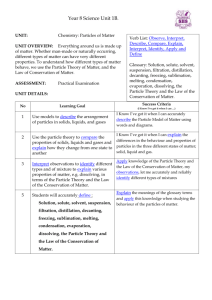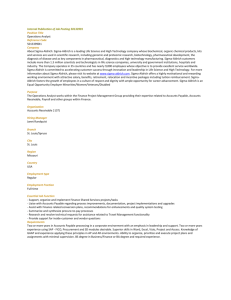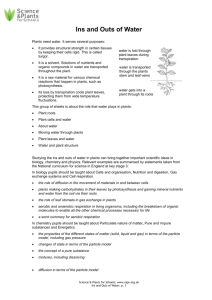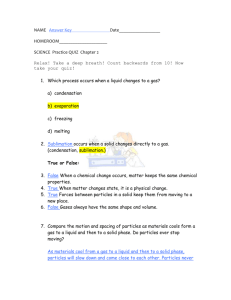aic14357-sup-0001-suppinfo
advertisement
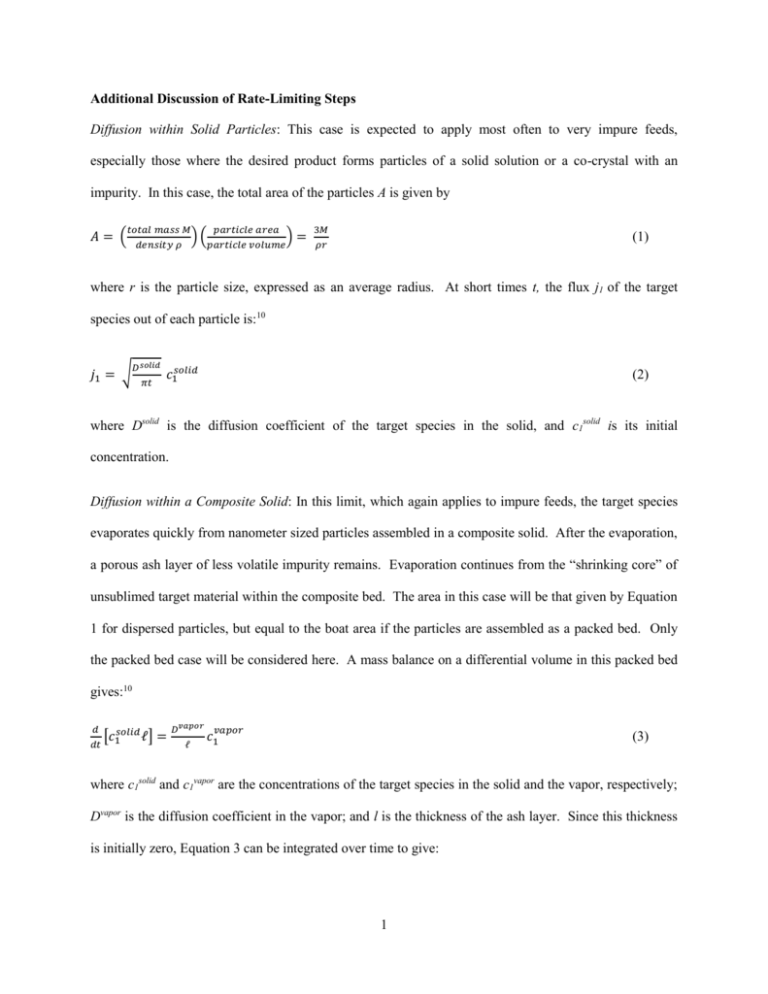
Additional Discussion of Rate-Limiting Steps Diffusion within Solid Particles: This case is expected to apply most often to very impure feeds, especially those where the desired product forms particles of a solid solution or a co-crystal with an impurity. In this case, the total area of the particles A is given by 𝑡𝑜𝑡𝑎𝑙 𝑚𝑎𝑠𝑠 𝑀 𝑝𝑎𝑟𝑡𝑖𝑐𝑙𝑒 𝑎𝑟𝑒𝑎 ) (𝑝𝑎𝑟𝑡𝑖𝑐𝑙𝑒 𝑣𝑜𝑙𝑢𝑚𝑒) 𝑑𝑒𝑛𝑠𝑖𝑡𝑦 𝜌 𝐴= ( = 3𝑀 𝜌𝑟 (1) where r is the particle size, expressed as an average radius. At short times t, the flux j1 of the target species out of each particle is:10 𝑠𝑜𝑙𝑖𝑑 𝐷 𝑗1 = √ 𝜋𝑡 𝑐1𝑠𝑜𝑙𝑖𝑑 (2) where Dsolid is the diffusion coefficient of the target species in the solid, and c1solid is its initial concentration. Diffusion within a Composite Solid: In this limit, which again applies to impure feeds, the target species evaporates quickly from nanometer sized particles assembled in a composite solid. After the evaporation, a porous ash layer of less volatile impurity remains. Evaporation continues from the “shrinking core” of unsublimed target material within the composite bed. The area in this case will be that given by Equation 1 for dispersed particles, but equal to the boat area if the particles are assembled as a packed bed. Only the packed bed case will be considered here. A mass balance on a differential volume in this packed bed gives:10 𝑑 [𝑐 𝑠𝑜𝑙𝑖𝑑 ℓ] 𝑑𝑡 1 = 𝐷 𝑣𝑎𝑝𝑜𝑟 𝑣𝑎𝑝𝑜𝑟 𝑐1 ℓ (3) where c1solid and c1vapor are the concentrations of the target species in the solid and the vapor, respectively; Dvapor is the diffusion coefficient in the vapor; and l is the thickness of the ash layer. Since this thickness is initially zero, Equation 3 can be integrated over time to give: 1 𝑣𝑎𝑝𝑜𝑟 𝑙=[ 2𝐷𝑣𝑎𝑝𝑜𝑟 𝑐1 𝑐1𝑠𝑜𝑙𝑖𝑑 𝑡 1/2 ] (4) The flux j1 out of the packed bed is thus 𝑣𝑎𝑝𝑜𝑟 𝑗1 = 𝐷𝑣𝑎𝑝𝑜𝑟 𝑐1 ℓ =[ 𝑣𝑎𝑝𝑜𝑟 𝑠𝑜𝑙𝑖𝑑 𝑐1 𝐷 𝑣𝑎𝑝𝑜𝑟 𝑐1 2𝑡 1/2 ] (5) and the flux increases with the square root of c1vapor, unlike the linear relationship shown by the other proposed mechanisms. Surface Desorption: In this limit, which applies to nearly pure particles, the key area is that of the particles themselves, as given by Equation 1. The particle size changes as sublimation continues, as shown by the mass balance:10 𝑑 4 [ 𝜋𝑟 3 𝑐1𝑠𝑜𝑙𝑖𝑑 ] 𝑑𝑡 3 = −𝑘4𝜋𝑟 2 𝑐1𝑠𝑜𝑙𝑖𝑑 (6) where k is a first order rate constant describing the rate of molecular detachment from the solid surface. If the initial particle radius is r0, Equation 6 is easily integrated to yield r = r0 – kt. This mechanism has been observed for the sublimation of many ammonium halides.11,12 The sublimation flux in this case is then just j1 = kc1solid. Taking into account the varying radius, the area given in Equation 1 can be combined with the flux, and when integrated over particle area and time, gives the mass sublimed. Diffusion Near Particles: Another case, closely related to the previous one, concerns small, nearly pure dispersed particles whose sublimation is controlled not by surface desorption but by diffusion from the particle surface into the surroundings. The mass balance on one particle is closely related to that in Equation 6: 𝑑 4 [ 𝑑𝑡 3 𝜋𝑟 3 𝑐1𝑠𝑜𝑙𝑖𝑑 ] = − [ 𝐷 𝑣𝑎𝑝𝑜𝑟 𝑟 𝑣𝑎𝑝𝑜𝑟 ] (4𝜋𝑟 2 )𝑐1 (7) which can be compared to Equation 6 where the rate constant has been replaced by diffusion.10 If the initial radius is r0, the integration of Equation 7 gives: 2 𝑟 2 = 𝑟02 − 𝑣𝑎𝑝𝑜𝑟 2𝐷𝑐1 𝑡 (8) 𝑐1𝑠𝑜𝑙𝑖𝑑 and the flux is: 𝑗1 = 2𝐷 𝑟 𝑣𝑎𝑝𝑜𝑟 𝑐1 (9) The mass sublimed is found from combining the last two equations and integrating over particle area and time. This case, which occurs in the sublimation of both iodine and aluminum oxide, was analyzed by Langmuir.13,14 Mass Transfer Out of the Boat: In situations where mass transfer of a nearly pure vapor controls the sublimation, the vapor between the particles now reaches saturation. There are two cases which are important: when sublimation is limited by mass transfer out of the boat, and when it is controlled by mass transfer along the tube. When mass transfer out of the boat is the slow step, the rate depends not on particle area, but on boat area. The flux is given by j1 = kc1vapor, where k is now a mass transfer coefficient for the product molecule in the vapor. The mass sublimed is obtained by integrating the flux over boat area and time. Synthetic Details 99.2% NPD synthetic protocol: To a 2-L cylindrical jacketed glass reactor equipped with an overhead mechanical stirrer, heating/cooling bath, water condenser, and bottom drain was added tris(dibenzylideneacetone)dipalladium(0) (Sigma-Aldrich Lot 72896APV, 0.534 g, 0.58mmol), 2dicyclohexylphosphino-2’,4’,6’-triisopropylbiphenyl (Sigma-Aldrich Lot H14U026, 1.252 g, 2.59 mmol), 4,4’-dibromobiphenyl (Sigma-Aldrich Lot MKBH5745V, 41.03 g, 131.5 mmol), N-phenyl-1naphthylamine (Sigma-Aldrich Lot MKBV1722V, 60.53 g, 276 mmol), and sodium tert-butoxide (Sigma-Aldrich Lot SHBB0144V, 37.8 g, 393.4 mmol).The headspace was flushed with nitrogen. Toluene (Fisher HPLC grade Lot 117121, 820 mL) was sparged with nitrogen for 30 minutes and added to the reactor and the agitation was started at 300 rpm. The reaction mixture was heated to 80-95 °C 3 (target of 95 °C) for 5.5 hours. The heating was turned off and the mixture was cooled to room temperature overnight as stirred. The mixture was filtered through a coarse glass sintered filter funnel. The reactor was rinsed with methanol (320.5 g) and this was used to reslurry and wash the filter cake. Additional methanol (323.5 g) was used to chromatographically wash the filter cake. The cake was partially dried on the filter to yield 129.6 g of wet cake which was placed in the glass drying dish and dried under vacuum (80 °C and 10 mmHg) for 4 hours to yield 70.09 g (90.6% yield) of yellow powder that was identified as NPD; 1H NMR; 400MHz, CDCl3: = 7.94 (d, J = 8.0, 2H), 7.88 (d, J = 8.0, 2H), 7.76 (d, J = 8.0, 2H), 7.45 (m, 4H), 7.35 (m, 8H), 7.21 (dd, J = 8.0, 8.0, 4H), 7.04 (m, 8H), 6.93 (dd, J = 8.0, 8.0, 2H). Subsequent syntheses prepared 69.08 g (89.3% yield) and 69.10 g (89.3% yield) of NPD, respectively. These batches were combined to give 206 g of NPD that was analyzed by HPLC to be 99.2% pure. 77.5% NPD synthetic protocol: To a 3-neck 1 L round bottom flask equipped with an overhead mechanical stirrer, heating mantle, thermoprobe, condenser, and nitrogen bubbler was added [1,1’bis(diphenylphosphino)ferrocene]dichloropalladium(II) (Sigma-Aldrich Lot SHBB5758V, 1.08 g, 1.48 mmol), 4,4’-dibromobiphenyl (Sigma-Aldrich Lot MKBH5745V, 20.01 g, 64.1 mmol), N-phenylnaphthylamine (Sigma-Aldrich Lot MKBH1722V, 29.54 g, 134.7 mmol), and sodium tert-butoxide (Sigma-Aldrich Lot 14396BPV, 18.92 g, 196.9 mmol). The flask was inerted with nitrogen. Toluene (Fisher HPLC grade lot 111565, 400 mL) was degassed by passing a stream of nitrogen through it for 5 minutes and then added to the reaction. The reaction was heated to 95 °C for 4 hours. In-process reaction samples (100 mL diluted with 5 mL THF and 1 mL injection) were analyzed at 4 hours. The reaction mixture was cooled to 25 °C and THF (100 mL) was added. The reaction mixture was passed through a bed of silica gel (139 g, 60 Å, 70-230 mesh) and the silica gel was eluted with toluene:THF (4:1, 500 mL). The effluent was combined and evaporated with a rotovap and the residue placed in a drying dish and dried in a vacuum oven (80 °C and 10 mmHg) for 4 hours yielding 37 g of product that was identified as 77.5% NPD by HPLC. 4 Detailed Analytical Procedure NPD samples were prepared as 2 mg/mL solutions in tetrahydrofuran. Three microliter aliquots of solutions were injected onto a Agilent 1200SL binary gradient liquid chromatograph coupled to a Agilent 6520 QTof, quadrupole-time of flight mass spectroscopy (MS) system via a dual spray electrospray (ES) interface operating in the positive ion (PI) mode. The liquid chromatography (LC) conditions included: column, Zorbax SB-C8, 3.5 µm, 4.6x150mm. Mobile phase: water/0.1 v% formic acid (88%): THF. Gradient programming: 0 min, 55%B; 15min, 75%B ; 20min, 75%B. Flow rate: 1.0mL/min. Oven temperature: 40°C. Detection wavelength: 210 to 600nm summed. The ES source conditions included: Gas Temp- 365°C, Gas Flow – 11ml/min, Capillary- 3.5 kV , Nebulizer – 45PSI, Fragmentor -145V. The time of flight (TOF) mass spectrometer was scanned from 50 to 1700 amu at a rate of 3 scans per second and alternating between the MS and MS/MS modes. Collision gas of nitrogen and collisions energies of 65V were employed in the MS/MS modes. Purity of the materials was determined by area percent assay of the summed UV response from 210 to 600 nm. MS Data (for Figure 2): A) (M+H)+ : 589.2651(C44H33N2); MS/MS – 217.0874 (C16H11N), 369.1496 (C28H19N), 293.1187 (C22H15N), 461.2003 (C34H25N2), 511.2160 (C38H27N2) B) (M+H)+ : 806.3531(C60H44N3); MS/MS – 218.0948 (C16H12N), 345.1491 (C26H19N), 714.2987 (C54H38N2), 461.1984 (C34H25N2), 588.2525 (C44H32N2), 166.0634 (C12H8N) C) (M+H)+ : 958.4142 (C72H52N3); MS/MS – 218.0962 (C16H12N), 497.2126 (C38H27N), 866.3621 (C66H46N2), 740.3158 (C56H40N2), 333.1375 (C24H17N2) 5



